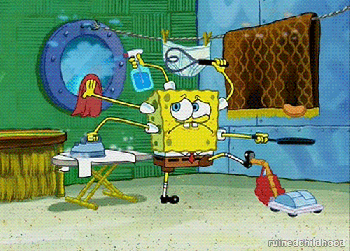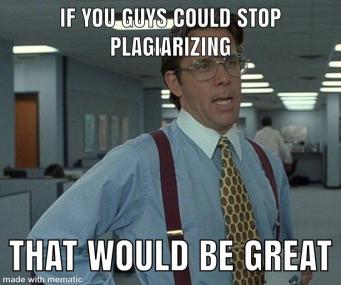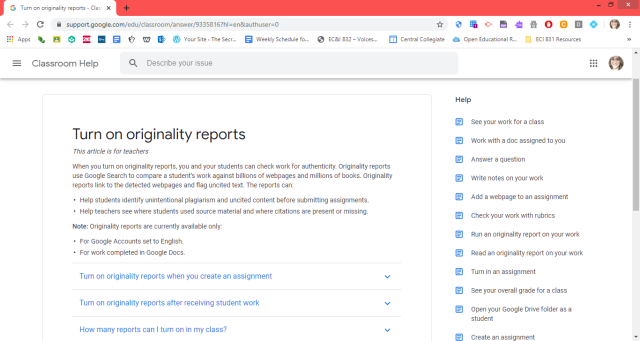After this week’s class, I feel like a complete novice when it comes to the legal issues on the internet and different platforms. How do you know if you are using something properly? What if I’m not? I really enjoyed the Fair Dealings Decision Tool and think it will help me with some of the dilemmas I’m currently facing in this new world of online learning. I think we can all agree the last few weeks have been both exhausting and overwhelming. When I began thinking about setting up my classroom online, I originally thought, piece of cake! Throw some things online and let the students do the rest. I did not realize HOW MUCH TIME these things take. I’m so used to my world of  “oh, I’ll just mention this in class” or “I’ll explain this assignment later” or “I don’t need to prep that – I’ll just go with the flow.” I learned quickly the online teaching world does not allow for that, and now I am forced to explain EVERYTHING in written word, or create a video explaining it, hoping I don’t forget a common question students will ask me. And even with all my prep work, I still missed things. I think this is fairly normal, as this is a brand new world for us all and wow is it tedious!
“oh, I’ll just mention this in class” or “I’ll explain this assignment later” or “I don’t need to prep that – I’ll just go with the flow.” I learned quickly the online teaching world does not allow for that, and now I am forced to explain EVERYTHING in written word, or create a video explaining it, hoping I don’t forget a common question students will ask me. And even with all my prep work, I still missed things. I think this is fairly normal, as this is a brand new world for us all and wow is it tedious!
Brad mentioned in his blog this week that teachers at his school were frenzied trying to grab every resource they could before being told to leave the school. I can agree with this mentality as I headed to the school myself to grab every little resource, I thought I needed at home, but then comes the problem of how will I share it with my students. If they don’t have the resource, how do I give it to them and properly? Sure, I could take a  picture and upload it to our google classroom for them to use, but is this the best practice? Depending on the resource used, I’ll be using that Decision Tool a lot as I continue to work on my online courses. Teaching an ELA class online is definitely a different experience and the hardest thing I’ve had to figure out so far is how to share literature. My students needed a novel, but although students can pick up novels from the school, most of them really don’t want to come get them. I’ve been struggling to find high school novels online so if anyone has any free resources let me know. Fortunately, I found an online version the novel I needed, and an audiobook on YouTube. I appeased my students for now! Still, making sure I am using the resources and stories I’ve always just shared in the classroom feels different sharing them online. Is it the same if it’s just for my students on my google classroom, or could there be consequences for sharing a short story pdf file I’ve always just read to my students in the classroom?
picture and upload it to our google classroom for them to use, but is this the best practice? Depending on the resource used, I’ll be using that Decision Tool a lot as I continue to work on my online courses. Teaching an ELA class online is definitely a different experience and the hardest thing I’ve had to figure out so far is how to share literature. My students needed a novel, but although students can pick up novels from the school, most of them really don’t want to come get them. I’ve been struggling to find high school novels online so if anyone has any free resources let me know. Fortunately, I found an online version the novel I needed, and an audiobook on YouTube. I appeased my students for now! Still, making sure I am using the resources and stories I’ve always just shared in the classroom feels different sharing them online. Is it the same if it’s just for my students on my google classroom, or could there be consequences for sharing a short story pdf file I’ve always just read to my students in the classroom?
The second legal issue I have always struggled with, and maybe even more as the years go on, is plagiarism. Students are getting VERY good at passing work off as their own when in fact, it is not. We even caught students buying essays this year. This led to some interventions and work on our policies as a school. We’ve spent some time developing education pieces to share with students and hopefully teach them  not just why it’s wrong, and how they will be kicked out of university if they do it later in life. This just gets the teenage eye roll as they gap out and ignore everything I just said. They know it’s wrong, but I think the piece that is missing is why it is wrong. Why do you need to give credit to others? What are the legal implications of stealing someone else’s work, beyond just getting kicked out of school? It needs to become more real for students outside of just writing essays inside classroom walls. In order for students to really understand why it is wrong, they need to be exposed to what actually happens in the real world when you get caught plagiarizing others work.
not just why it’s wrong, and how they will be kicked out of university if they do it later in life. This just gets the teenage eye roll as they gap out and ignore everything I just said. They know it’s wrong, but I think the piece that is missing is why it is wrong. Why do you need to give credit to others? What are the legal implications of stealing someone else’s work, beyond just getting kicked out of school? It needs to become more real for students outside of just writing essays inside classroom walls. In order for students to really understand why it is wrong, they need to be exposed to what actually happens in the real world when you get caught plagiarizing others work.
Instead of penalizing students and giving them zeroes because they plagiarized, I think it’s a better practice to teach them how to avoid it, like Melinda discussed in her blog post. She also mentioned that lots of times, students don’t even understand that what they have done is wrong or what constitutes as plagiarism. This is especially true for EAL students, like Melinda discussed. Imagine trying to learn a new language, and then imagine trying to write an essay in that new language. Imagine finding something online that says exactly what you want to say in your essay, but you don’t have the understanding of that language yet to turn that information into your own words, so you copy it. Plagiarism. Is it wrong? Yes. Do students know this? Yes, most of the time. Do they understand how to avoid it? In most cases, no and this is because there seems to be a gap in that learning.
Students need to learn how to avoid and need practice paraphrasing. This seems to be a lost skill. Students need opportunities to try writing and researching, and then see where they can improve when they are quoting or citing things. Recently, I’ve been looking into more plagiarism software like Turnitin! It’s an excellent resource, but it costs a lot of money. What I decided to do in the classroom to hopeful combat some of the plagiarism issue is to use google classroom. They recently added an update to the assignment portion that allows for an originality check.

This gives students three opportunities to submit their work, and three opportunities to fix any plagiarism in their writing. Unfortunately, school was let out before I could work with my students on this tool and explain how it works, but am I going to try it with my online students? Absolutely! It might take a little more time and patience, but I’m hopefully going to use it, and then use it in the future to help students learn how to avoid plagiarism in their writing, so they can become more responsible and ethical citizens online and offline.
Until next time,
Shelby


Another well elaborated post Shelby. I share your pain in trying to establish a new style of pedagogy and the walls of copyright we are hitting on this process. I also see the plagiarism issue in my school and I’ve had to have good and profound discussions with students to help them understand the impact it can have. I always give my students a second chance. One year, I created new students in my classroom every time I received a work that was plagiarized. I attributed the grade to the original author as it was my own student. By then end of the year, I had an enormous class with very well know people! Good luck in the weeks and months to come, we can get through this because teachers always do!
LikeLiked by 1 person
Hi Daniel,
Thanks for the response. That is such a fun idea to make students accountable and learn from the experiences of plagiarism. Good luck to you as well!
LikeLike
Great post Shelby!
I relate so much with you on delivering online learning. All the little things we can explain and mention in class. Our online teaching has to be SO detailed. I miss the classroom so much!
I enjoy learning about your perspective from the high school side of education. I never have to worry about plagiarism from my students writing in their journals each day. When I reflect on high school students and reading your post I thought about their world. I’ve been looking into TikTok and most of it is copying other peoples dances and posting your own. That’s the culture they are in and it is okay for them to copy and post. We really have to teach at a young age how important it is to give your own work and words in a classroom setting.
Thanks for your thoughts!
Christina
LikeLiked by 1 person
Exactly Christina! They have learned through their culture that this is acceptable. In some cases, like TikTok, it’s encouraged, but in other places it is not. That’s confusing and I totally understand why students are confused by those terms. I agree with you that it is important to teach them how to distinguish when and where and with this new online world, it’s a perfect opportunity.
LikeLike
Hi Shelby,
You brought up so many great points in your blog post. I absolutely enjoyed reading it. During my Blended Learning class with Alec, I experienced how much work it is to develop an online or blended course. As you mentioned, you have to pay attention to every single little detail, which makes it very time consuming.
If you are still looking for resources feel free to check these out. They might work with your high school students:
Sora (online library) – https://company.overdrive.com/k-12-schools/discover-sora/
Article of the day – http://ourenglishclass.net/resources/english-i-summer-reading/
Under the class note tab there is useful information to teach various skills, such as paraphrasing.
NewsELA – https://newsela.com
englishforeveryone.com
Regarding plagiarism, I like the idea of giving students three opportunities to go back and improve their writing while focusing on “writing with integrity”. I do feel that we, teachers have to really know our students and make adaptations if needed to set them up for success.
I wish you the very best!
Melinda
LikeLiked by 1 person
Thanks so much for the resources Melinda! I will be sure to check them out and thank you for reading 🙂
LikeLike
Great blog post Shelby! I find one of the issues I come across with written assignments from students is plagiarism, no matter how many times you go over what its definition is some still really struggle to grasp that they can’t just copy and paste, without acknowledging their references properly. At times I feel more like an investigative detective looking into students written reports to make sure they are clean of plagiarism.
LikeLiked by 1 person
I totally agree Adam! It adds a whole other level to grading papers, that’s for sure. It can get really frustrating too. All we can do is keep trying to teach them the proper ways and hope they eventually get it! Thanks for reading!
LikeLike